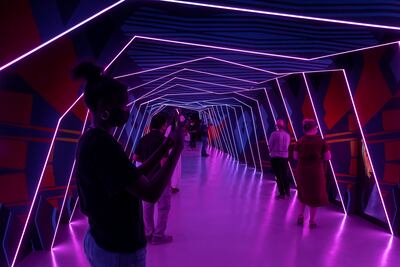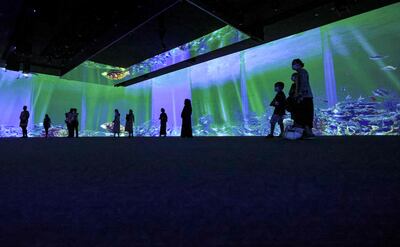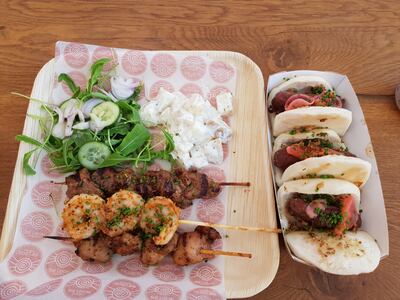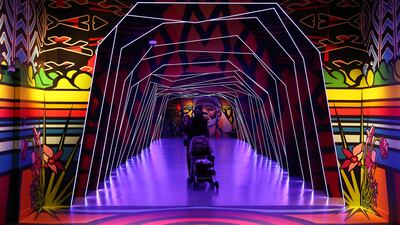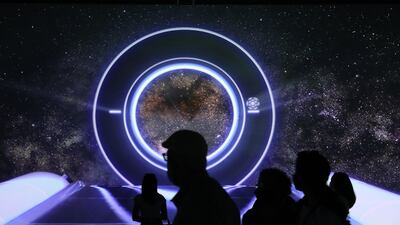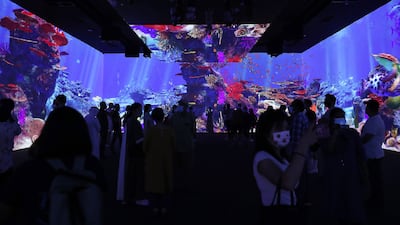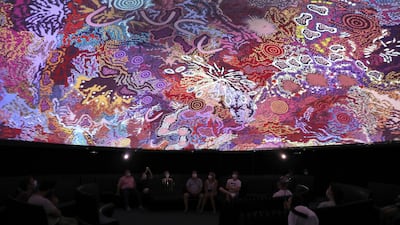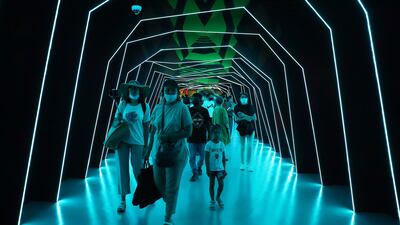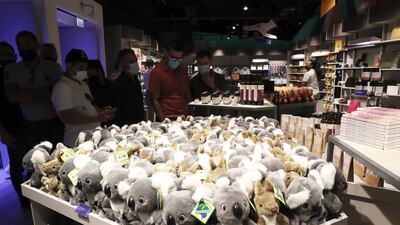Going to an Australian showcase at international events is often a disconcerting experience.
As a citizen of Down Under for a little under 30 years, this is something I've noticed goes against the grain of the Australian character.
We are not really big on self-celebration, patting ourselves on the back or standing out.
LIVE BLOG: Updates and live coverage from Expo 2020 Dubai
It is a belief that was crystallised by a friend, a notable Aussie cultural figure in the UAE, upon leaving the Australia Pavilion at Expo 2020 Dubai this week.
“Well, is that it?” she said, with a grin.
This was more a colloquialism than a flippant mark.
We are a great host nation (from two Olympic Games to several Hollywood films including The Matrix) but never comfortable with taking centre stage.
My mate’s remark is so accurate.
A country under construction
The tech and eco-savvy pavilion, located at the Mobility District, does a fine job of capturing a country under construction.
It is one being built on the back of a startlingly multicultural population and based on the blue-print laid by the country’s diverse indigenous population thousands of years before European settlers arrived at the turn of the 19th century.
It is also a reminder that, despite its growing pains, Australia provided many of us with a generous platform to be the best we can be.
The fact it stands beside the Malaysian pavilion and an international constellation of others, from Croatia and France to Thailand, is sentimentally apt.
From Abu Dhabi to Australia
Four decades ago, I was born in Abu Dhabi, as part of the city's small Eritrean community. At that time, a lot of us took opportunities to resettle abroad for education and citizenship.
A few of my childhood friends left the UAE in their late teens for Kuala Lumpur to get university degrees. I went to Australia when I was much younger.
It's a cosmopolitan country, especially in Melbourne, where I first arrived as a nine-year-old. It gave me my first insight into European and Asian cultures, through world-leading arts and culture festivals often organised by migrants from those communities.
It is an aspect digitised in the first of three sections of the pavilion: a neon-lit corridor with visual installations of migrants, young and old, describing their arrival in Australia.
It's a moving exhibition, for it reminds me of the story of a spirited African woman arriving in Australia in 1990 as a single parent with three children. Her name is Zahra Baho, my mother, and she told her story at an exhibition at Melbourne’s Immigration Museum in 2017.
Under the guidance of stars
The pavilion's centrepiece is the Star Dreaming Gallery, essentially a planetarium illustrating how Australia's indigenous communities were among the world's first astronomers.
Through the observance of their surroundings, they made accurate measurements of stars, galaxies and the changing of the seasons.
As someone who has also lived in the UAE on and off for half of my life, this felt familiar.
After all, this is a region where outer space is looked upon for guidance.
Ramadan is announced through the spotting of the crescent moon, while in late August we receive the welcome news by the Arab Union for Astronomy and Space Sciences that winter is coming with the arrival of the Suhail star, long mentioned in Arab poetry and Bedouin parables, in UAE skies.
A nod to the future
More synergy is found in the pavilion’s final showcase, Annika's Journey, a multimedia exhibition following a young girl as she takes us through Australia's various efforts to build a sustainable future by looking after its environment.
Some of the featured conservation initiatives, from the Great Barrier Reef to the mountainous terrain of Katherine Gorge in the interior region of the Northern Territory, echo some of the work done by authorities in the UAE, from Al Hefaiyah Mountain Conservation Centre in Sharjah to Abu Dhabi's Jubail Mangrove Park.
The mention of Australia's ongoing efforts to build the world’s largest radio telescope in the country's west also complements the UAE's recent success with the Mars Mission.
That Aussie feeling
While the heady subjects covered are inspiring, I discover that true feeling of “Oz” in the lovely outdoor courtyard area.
Built from Tasmanian cross-laminated timber, the sandy brown structure resembles a mini version of Federation Square in the heart of Melbourne.
Those vibes are further channelled by the city's key attractions: the excellent coffee served in the Melbourne Lane coffee truck, and hip food options such as the sausage bao (Vietnamese sausage buns) from the Local Cafe.
“No, this is it!” I tell my friend, as we toast our lattes.
From my bench, I see people of various cultures and religions chatting away while a musician on stage performs a bluesy guitar solo.
This feels like Australia as much as the UAE.
Both feel like home.
Joker: Folie a Deux
Starring: Joaquin Phoenix, Lady Gaga, Brendan Gleeson
Director: Todd Phillips
Rating: 2/5
INDIA'S%20TOP%20INFLUENCERS
%3Cp%3E%3Cstrong%3EBhuvan%20Bam%3C%2Fstrong%3E%3Cbr%3E%3Ca%20href%3D%22https%3A%2F%2Fwww.instagram.com%2Fbhuvan.bam22%2F%3Fhl%3Den%22%20target%3D%22_self%22%3EInstagram%3C%2Fa%3E%20followers%3A%2016.1%20million%3Cbr%3EBhuvan%20Bam%20is%20a%2029-year-old%20comedian%20and%20actor%20from%20Delhi%2C%20who%20started%20out%20with%20YouTube%20channel%2C%20%E2%80%9CBB%20Ki%20Vines%E2%80%9D%20in%202015%2C%20which%20propelled%20the%20social%20media%20star%20into%20the%20limelight%20and%20made%20him%20sought-after%20among%20brands.%3Cbr%3E%3Cstrong%3EKusha%20Kapila%3C%2Fstrong%3E%3Cbr%3E%3Ca%20href%3D%22https%3A%2F%2Fwww.instagram.com%2Fkushakapila%2F%3Fhl%3Den%22%20target%3D%22_self%22%3EInstagram%3C%2Fa%3E%20followers%3A%203.1%20million%3Cbr%3EKusha%20Kapila%20is%20a%20fashion%20editor%20and%20actress%2C%20who%20has%20collaborated%20with%20brands%20including%20Google.%20She%20focuses%20on%20sharing%20light-hearted%20content%20and%20insights%20into%20her%20life%20as%20a%20rising%20celebrity.%3Cbr%3E%3Cstrong%3EDiipa%20Khosla%3C%2Fstrong%3E%3Cbr%3E%3Ca%20href%3D%22https%3A%2F%2Fwww.instagram.com%2Fdiipakhosla%2F%3Fhl%3Den%22%20target%3D%22_self%22%3EInstagram%3C%2Fa%3E%20followers%3A%201.8%20million%3Cbr%3EDiipa%20Khosla%20started%20out%20as%20a%20social%20media%20manager%20before%20branching%20out%20to%20become%20one%20of%20India's%20biggest%20fashion%20influencers%2C%20with%20collaborations%20including%20MAC%20Cosmetics.%3Cbr%3E%3Cstrong%3EKomal%20Pandey%3Cbr%3E%3C%2Fstrong%3E%3Ca%20href%3D%22https%3A%2F%2Fwww.instagram.com%2Fkomalpandeyofficial%2F%3Fhl%3Den%22%20target%3D%22_self%22%3EInstagram%3C%2Fa%3E%20followers%3A%201.8%20million%3Cbr%3EKomal%20Pandey%20is%20a%20fashion%20influencer%20who%20has%20partnered%20with%20more%20than%20100%20brands%2C%20including%20Olay%20and%20smartphone%20brand%20Vivo%20India.%3Cbr%3E%3Cstrong%3ENikhil%20Sharma%3C%2Fstrong%3E%3Cbr%3E%3Ca%20href%3D%22https%3A%2F%2Fwww.instagram.com%2Fnikkkhil%2F%3Fhl%3Den%22%20target%3D%22_self%22%3EInstagram%3C%2Fa%3E%20followers%3A%201.4%20million%3Cbr%3ENikhil%20Sharma%20from%20Mumbai%20began%20his%20online%20career%20through%20vlogs%20about%20his%20motorcycle%20trips.%20He%20has%20become%20a%20lifestyle%20influencer%20and%20has%20created%20his%20own%20clothing%20line.%3Cbr%3E%3Cem%3ESource%3A%20Hireinfluence%2C%20various%3C%2Fem%3E%3Cbr%3E%3C%2Fp%3E%0A
Zimbabwe v UAE, ODI series
All matches at the Harare Sports Club:
1st ODI, Wednesday, April 10
2nd ODI, Friday, April 12
3rd ODI, Sunday, April 14
4th ODI, Tuesday, April 16
UAE squad: Mohammed Naveed (captain), Rohan Mustafa, Ashfaq Ahmed, Shaiman Anwar, Mohammed Usman, CP Rizwan, Chirag Suri, Mohammed Boota, Ghulam Shabber, Sultan Ahmed, Imran Haider, Amir Hayat, Zahoor Khan, Qadeer Ahmed
Seven tips from Emirates NBD
1. Never respond to e-mails, calls or messages asking for account, card or internet banking details
2. Never store a card PIN (personal identification number) in your mobile or in your wallet
3. Ensure online shopping websites are secure and verified before providing card details
4. Change passwords periodically as a precautionary measure
5. Never share authentication data such as passwords, card PINs and OTPs (one-time passwords) with third parties
6. Track bank notifications regarding transaction discrepancies
7. Report lost or stolen debit and credit cards immediately
About Tenderd
Started: May 2018
Founder: Arjun Mohan
Based: Dubai
Size: 23 employees
Funding: Raised $5.8m in a seed fund round in December 2018. Backers include Y Combinator, Beco Capital, Venturesouq, Paul Graham, Peter Thiel, Paul Buchheit, Justin Mateen, Matt Mickiewicz, SOMA, Dynamo and Global Founders Capital
UAE currency: the story behind the money in your pockets
What went into the film
25 visual effects (VFX) studios
2,150 VFX shots in a film with 2,500 shots
1,000 VFX artists
3,000 technicians
10 Concept artists, 25 3D designers
New sound technology, named 4D SRL
Packages which the US Secret Service said contained possible explosive devices were sent to:
- Former first lady Hillary Clinton
- Former US president Barack Obama
- Philanthropist and businessman George Soros
- Former CIA director John Brennan at CNN's New York bureau
- Former Attorney General Eric Holder (delivered to former DNC chair Debbie Wasserman Schultz)
- California Congresswoman Maxine Waters (two devices)
RedCrow Intelligence Company Profile
Started: 2016
Founders: Hussein Nasser Eddin, Laila Akel, Tayeb Akel
Based: Ramallah, Palestine
Sector: Technology, Security
# of staff: 13
Investment: $745,000
Investors: Palestine’s Ibtikar Fund, Abu Dhabi’s Gothams and angel investors
Key findings of Jenkins report
- Founder of the Muslim Brotherhood, Hassan al Banna, "accepted the political utility of violence"
- Views of key Muslim Brotherhood ideologue, Sayyid Qutb, have “consistently been understood” as permitting “the use of extreme violence in the pursuit of the perfect Islamic society” and “never been institutionally disowned” by the movement.
- Muslim Brotherhood at all levels has repeatedly defended Hamas attacks against Israel, including the use of suicide bombers and the killing of civilians.
- Laying out the report in the House of Commons, David Cameron told MPs: "The main findings of the review support the conclusion that membership of, association with, or influence by the Muslim Brotherhood should be considered as a possible indicator of extremism."
The biog
Name: Salvador Toriano Jr
Age: 59
From: Laguna, The Philippines
Favourite dish: Seabass or Fish and Chips
Hobbies: When he’s not in the restaurant, he still likes to cook, along with walking and meeting up with friends.
Company Profile
Name: Thndr
Started: 2019
Co-founders: Ahmad Hammouda and Seif Amr
Sector: FinTech
Headquarters: Egypt
UAE base: Hub71, Abu Dhabi
Current number of staff: More than 150
Funds raised: $22 million
Wicked: For Good
Director: Jon M Chu
Starring: Ariana Grande, Cynthia Erivo, Jonathan Bailey, Jeff Goldblum, Michelle Yeoh, Ethan Slater
Rating: 4/5
Our legal consultants
Name: Hassan Mohsen Elhais
Position: legal consultant with Al Rowaad Advocates and Legal Consultants.
Skoda Superb Specs
Engine: 2-litre TSI petrol
Power: 190hp
Torque: 320Nm
Price: From Dh147,000
Available: Now
Representing%20UAE%20overseas
%3Cp%3E%0DIf%20Catherine%20Richards%20debuts%20for%20Wales%20in%20the%20Six%20Nations%2C%20she%20will%20be%20the%20latest%20to%20have%20made%20it%20from%20the%20UAE%20to%20the%20top%20tier%20of%20the%20international%20game%20in%20the%20oval%20ball%20codes.%0D%3Cbr%3E%20%0D%3Cbr%3E%3Cstrong%3ESeren%20Gough-Walters%20(Wales%20rugby%20league)%3C%2Fstrong%3E%0D%3Cbr%3EBorn%20in%20Dubai%2C%20raised%20in%20Sharjah%2C%20and%20once%20an%20immigration%20officer%20at%20the%20British%20Embassy%20in%20Abu%20Dhabi%2C%20she%20debuted%20for%20Wales%20in%20rugby%20league%20in%202021.%0D%3Cbr%3E%20%0D%3Cbr%3E%3Cstrong%3ESophie%20Shams%20(England%20sevens)%3C%2Fstrong%3E%0D%3Cbr%3EWith%20an%20Emirati%20father%20and%20English%20mother%2C%20Shams%20excelled%20at%20rugby%20at%20school%20in%20Dubai%2C%20and%20went%20on%20to%20represent%20England%20on%20the%20sevens%20circuit.%20%0D%3Cbr%3E%20%0D%3Cbr%3E%3Cstrong%3EFiona%20Reidy%20(Ireland)%3C%2Fstrong%3E%0D%3Cbr%3EMade%20her%20Test%20rugby%20bow%20for%20Ireland%20against%20England%20in%202015%2C%20having%20played%20for%20four%20years%20in%20the%20capital%20with%20Abu%20Dhabi%20Harlequins%20previously.%0D%3C%2Fp%3E%0A
Graduated from the American University of Sharjah
She is the eldest of three brothers and two sisters
Has helped solve 15 cases of electric shocks
Enjoys travelling, reading and horse riding
The lowdown
Badla
Rating: 2.5/5
Produced by: Red Chillies, Azure Entertainment
Director: Sujoy Ghosh
Cast: Amitabh Bachchan, Taapsee Pannu, Amrita Singh, Tony Luke
The specs
Engine: 6.2-litre V8
Transmission: seven-speed auto
Power: 420 bhp
Torque: 624Nm
Price: from Dh293,200
On sale: now
COMPANY%20PROFILE
%3Cp%3E%3Cstrong%3ECompany%20name%3A%3C%2Fstrong%3E%20Sav%3Cbr%3E%3Cstrong%3EStarted%3A%3C%2Fstrong%3E%202021%3Cbr%3E%3Cstrong%3EFounder%3A%3C%2Fstrong%3E%20Purvi%20Munot%3Cbr%3E%3Cstrong%3EBased%3A%3C%2Fstrong%3E%20Dubai%3Cbr%3E%3Cstrong%3EIndustry%3A%3C%2Fstrong%3E%20FinTech%3Cbr%3E%3Cstrong%3EFunding%3A%3C%2Fstrong%3E%20%24750%2C000%20as%20of%20March%202023%3Cbr%3E%3Cstrong%3EInvestors%3A%3C%2Fstrong%3E%20Angel%20investors%3C%2Fp%3E%0A
Specs
Engine: Duel electric motors
Power: 659hp
Torque: 1075Nm
On sale: Available for pre-order now
Price: On request
UAE currency: the story behind the money in your pockets
What is hepatitis?
Hepatitis is an inflammation of the liver, which can lead to fibrosis (scarring), cirrhosis or liver cancer.
There are 5 main hepatitis viruses, referred to as types A, B, C, D and E.
Hepatitis C is mostly transmitted through exposure to infective blood. This can occur through blood transfusions, contaminated injections during medical procedures, and through injecting drugs. Sexual transmission is also possible, but is much less common.
People infected with hepatitis C experience few or no symptoms, meaning they can live with the virus for years without being diagnosed. This delay in treatment can increase the risk of significant liver damage.
There are an estimated 170 million carriers of Hepatitis C around the world.
The virus causes approximately 399,000 fatalities each year worldwide, according to WHO.
Essentials
The flights
Emirates and Etihad fly direct from the UAE to Los Angeles, from Dh4,975 return, including taxes. The flight time is 16 hours. Alaska Airlines, United Airlines, Delta Air Lines, Aeromexico and Southwest all fly direct from Los Angeles to San Jose del Cabo from Dh1,243 return, including taxes. The flight time is two-and-a-half hours.
The trip
Lindblad Expeditions National Geographic’s eight-day Whales Wilderness itinerary costs from US$6,190 (Dh22,736) per person, twin share, including meals, accommodation and excursions, with departures in March and April 2018.
Fixtures
Opening day Premier League fixtures for August 9-11
August 9
Liverpool v Norwich 11pm
August 10
West Ham v Man City 3.30pm
Bournemouth v Sheffield Utd 6pm
Burnley v Southampton 6pm
C Palace v Everton 6pm
Leicester v Wolves 6pm
Watford v Brighton 6pm
Tottenham v Aston Villa 8.30pm
August 11
Newcastle v Arsenal 5pm
Man United v Chelsea 7.30pm
Why seagrass matters
- Carbon sink: Seagrass sequesters carbon up to 35X faster than tropical rainforests
- Marine nursery: Crucial habitat for juvenile fish, crustations, and invertebrates
- Biodiversity: Support species like sea turtles, dugongs, and seabirds
- Coastal protection: Reduce erosion and improve water quality
The Two Popes
Director: Fernando Meirelles
Stars: Anthony Hopkins, Jonathan Pryce
Four out of five stars
The biog
Age: 30
Position: Senior lab superintendent at Emirates Global Aluminium
Education: Bachelor of science in chemical engineering, post graduate degree in light metal reduction technology
Favourite part of job: The challenge, because it is challenging
Favourite quote: “Be the change you wish to see in the world,” Gandi
More Expo 2020 Dubai pavilions:
UAE v Gibraltar
What: International friendly
When: 7pm kick off
Where: Rugby Park, Dubai Sports City
Admission: Free
Online: The match will be broadcast live on Dubai Exiles’ Facebook page
UAE squad: Lucas Waddington (Dubai Exiles), Gio Fourie (Exiles), Craig Nutt (Abu Dhabi Harlequins), Phil Brady (Harlequins), Daniel Perry (Dubai Hurricanes), Esekaia Dranibota (Harlequins), Matt Mills (Exiles), Jaen Botes (Exiles), Kristian Stinson (Exiles), Murray Reason (Abu Dhabi Saracens), Dave Knight (Hurricanes), Ross Samson (Jebel Ali Dragons), DuRandt Gerber (Exiles), Saki Naisau (Dragons), Andrew Powell (Hurricanes), Emosi Vacanau (Harlequins), Niko Volavola (Dragons), Matt Richards (Dragons), Luke Stevenson (Harlequins), Josh Ives (Dubai Sports City Eagles), Sean Stevens (Saracens), Thinus Steyn (Exiles)
FIXTURES
Thu Mar 15 – West Indies v Afghanistan, UAE v Scotland
Fri Mar 16 – Ireland v Zimbabwe
Sun Mar 18 – Ireland v Scotland
Mon Mar 19 – West Indies v Zimbabwe
Tue Mar 20 – UAE v Afghanistan
Wed Mar 21 – West Indies v Scotland
Thu Mar 22 – UAE v Zimbabwe
Fri Mar 23 – Ireland v Afghanistan
The top two teams qualify for the World Cup
Classification matches
The top-placed side out of Papua New Guinea, Hong Kong or Nepal will be granted one-day international status. UAE and Scotland have already won ODI status, having qualified for the Super Six.
Thu Mar 15 – Netherlands v Hong Kong, PNG v Nepal
Sat Mar 17 – 7th-8th place playoff, 9th-10th place playoff
The smuggler
Eldarir had arrived at JFK in January 2020 with three suitcases, containing goods he valued at $300, when he was directed to a search area.
Officers found 41 gold artefacts among the bags, including amulets from a funerary set which prepared the deceased for the afterlife.
Also found was a cartouche of a Ptolemaic king on a relief that was originally part of a royal building or temple.
The largest single group of items found in Eldarir’s cases were 400 shabtis, or figurines.
Khouli conviction
Khouli smuggled items into the US by making false declarations to customs about the country of origin and value of the items.
According to Immigration and Customs Enforcement, he provided “false provenances which stated that [two] Egyptian antiquities were part of a collection assembled by Khouli's father in Israel in the 1960s” when in fact “Khouli acquired the Egyptian antiquities from other dealers”.
He was sentenced to one year of probation, six months of home confinement and 200 hours of community service in 2012 after admitting buying and smuggling Egyptian antiquities, including coffins, funerary boats and limestone figures.
For sale
A number of other items said to come from the collection of Ezeldeen Taha Eldarir are currently or recently for sale.
Their provenance is described in near identical terms as the British Museum shabti: bought from Salahaddin Sirmali, "authenticated and appraised" by Hossen Rashed, then imported to the US in 1948.
- An Egyptian Mummy mask dating from 700BC-30BC, is on offer for £11,807 ($15,275) online by a seller in Mexico
- A coffin lid dating back to 664BC-332BC was offered for sale by a Colorado-based art dealer, with a starting price of $65,000
- A shabti that was on sale through a Chicago-based coin dealer, dating from 1567BC-1085BC, is up for $1,950
Wenger's Arsenal reign in numbers
1,228 - games at the helm, ahead of Sunday's Premier League fixture against West Ham United.
704 - wins to date as Arsenal manager.
3 - Premier League title wins, the last during an unbeaten Invincibles campaign of 2003/04.
1,549 - goals scored in Premier League matches by Wenger's teams.
10 - major trophies won.
473 - Premier League victories.
7 - FA Cup triumphs, with three of those having come the last four seasons.
151 - Premier League losses.
21 - full seasons in charge.
49 - games unbeaten in the Premier League from May 2003 to October 2004.
Tips for job-seekers
- Do not submit your application through the Easy Apply button on LinkedIn. Employers receive between 600 and 800 replies for each job advert on the platform. If you are the right fit for a job, connect to a relevant person in the company on LinkedIn and send them a direct message.
- Make sure you are an exact fit for the job advertised. If you are an HR manager with five years’ experience in retail and the job requires a similar candidate with five years’ experience in consumer, you should apply. But if you have no experience in HR, do not apply for the job.
David Mackenzie, founder of recruitment agency Mackenzie Jones Middle East
COMPANY%20PROFILE
%3Cp%3E%3Cstrong%3ECompany%20name%3A%3C%2Fstrong%3E%20Revibe%20%0D%3Cbr%3E%3Cstrong%3EStarted%3A%3C%2Fstrong%3E%202022%0D%3Cbr%3E%3Cstrong%3EFounders%3A%3C%2Fstrong%3E%20Hamza%20Iraqui%20and%20Abdessamad%20Ben%20Zakour%20%0D%3Cbr%3E%3Cstrong%3EBased%3A%3C%2Fstrong%3E%20UAE%20%0D%3Cbr%3E%3Cstrong%3EIndustry%3A%3C%2Fstrong%3E%20Refurbished%20electronics%20%0D%3Cbr%3E%3Cstrong%3EFunds%20raised%20so%20far%3A%3C%2Fstrong%3E%20%2410m%20%0D%3Cbr%3E%3Cstrong%3EInvestors%3A%20%3C%2Fstrong%3EFlat6Labs%2C%20Resonance%20and%20various%20others%0D%3C%2Fp%3E%0A
COMPANY%20PROFILE
%3Cp%3E%3Cstrong%3EName%3A%20%3C%2Fstrong%3ESmartCrowd%0D%3Cbr%3E%3Cstrong%3EStarted%3A%20%3C%2Fstrong%3E2018%0D%3Cbr%3E%3Cstrong%3EFounder%3A%20%3C%2Fstrong%3ESiddiq%20Farid%20and%20Musfique%20Ahmed%0D%3Cbr%3E%3Cstrong%3EBased%3A%20%3C%2Fstrong%3EDubai%0D%3Cbr%3E%3Cstrong%3ESector%3A%20%3C%2Fstrong%3EFinTech%20%2F%20PropTech%0D%3Cbr%3E%3Cstrong%3EInitial%20investment%3A%20%3C%2Fstrong%3E%24650%2C000%0D%3Cbr%3E%3Cstrong%3ECurrent%20number%20of%20staff%3A%3C%2Fstrong%3E%2035%0D%3Cbr%3E%3Cstrong%3EInvestment%20stage%3A%20%3C%2Fstrong%3ESeries%20A%0D%3Cbr%3E%3Cstrong%3EInvestors%3A%20%3C%2Fstrong%3EVarious%20institutional%20investors%20and%20notable%20angel%20investors%20(500%20MENA%2C%20Shurooq%2C%20Mada%2C%20Seedstar%2C%20Tricap)%3C%2Fp%3E%0A
Jetour T1 specs
Engine: 2-litre turbocharged
Power: 254hp
Torque: 390Nm
Price: From Dh126,000
Available: Now
DUNE%3A%20PART%20TWO
%3Cp%3E%3Cstrong%3EDirector%3A%3C%2Fstrong%3E%20Denis%20Villeneuve%3C%2Fp%3E%0A%3Cp%3E%3Cstrong%3EStarring%3A%3C%2Fstrong%3E%20Timothee%20Chamalet%2C%20Zendaya%2C%20Austin%20Butler%3C%2Fp%3E%0A%3Cp%3E%3Cstrong%3ERating%3A%3C%2Fstrong%3E%205%2F5%3C%2Fp%3E%0A
GAC GS8 Specs
Engine: 2.0-litre 4cyl turbo
Power: 248hp at 5,200rpm
Torque: 400Nm at 1,750-4,000rpm
Transmission: 8-speed auto
Fuel consumption: 9.1L/100km
On sale: Now
Price: From Dh149,900
Dubai Bling season three
Cast: Loujain Adada, Zeina Khoury, Farhana Bodi, Ebraheem Al Samadi, Mona Kattan, and couples Safa & Fahad Siddiqui and DJ Bliss & Danya Mohammed
Rating: 1/5
Who has lived at The Bishops Avenue?
- George Sainsbury of the supermarket dynasty, sugar magnate William Park Lyle and actress Dame Gracie Fields were residents in the 1930s when the street was only known as ‘Millionaires’ Row’.
- Then came the international super rich, including the last king of Greece, Constantine II, the Sultan of Brunei and Indian steel magnate Lakshmi Mittal who was at one point ranked the third richest person in the world.
- Turkish tycoon Halis Torprak sold his mansion for £50m in 2008 after spending just two days there. The House of Saud sold 10 properties on the road in 2013 for almost £80m.
- Other residents have included Iraqi businessman Nemir Kirdar, singer Ariana Grande, holiday camp impresario Sir Billy Butlin, businessman Asil Nadir, Paul McCartney’s former wife Heather Mills.
Hunting park to luxury living
- Land was originally the Bishop of London's hunting park, hence the name
- The road was laid out in the mid 19th Century, meandering through woodland and farmland
- Its earliest houses at the turn of the 20th Century were substantial detached properties with extensive grounds
Business Insights
- As per the document, there are six filing options, including choosing to report on a realisation basis and transitional rules for pre-tax period gains or losses.
- SMEs with revenue below Dh3 million per annum can opt for transitional relief until 2026, treating them as having no taxable income.
- Larger entities have specific provisions for asset and liability movements, business restructuring, and handling foreign permanent establishments.
